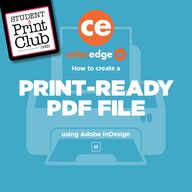
Return to flip book view
Message PRINT-READYPDF FILEHow to create ausing Adobe InDesign
Things to check before you create your print-ready PDF file...ENSURE ALL YOUR IMAGES ARE LINKEDENSURE ALL YOUR IMAGES ARE CMYK AND 300DPIADD BLEED AROUND THE EDGES OF YOUR DOCUMENT TO AVOID LOSING CONTENTMAKE YOUR PDF PRESS QUALITY, ADD CROP AND BLEED MARKSWE’LL TAKE IT FROM THERE AND PRODUCE YOUR PROJECT IN THE MOST PROFESSIONAL WAY POSSIBLE!CHECKLIST:1. LINKS2. COLOUR PROFILE3. BLEED4. EXPORT THE FILE TO PDF5. SEND YOUR PDF TO
Here at , we do not recommend the use of Photoshop to create a print-ready PDF. Photoshop is a great software for image editing and manipulating, however, it’s not built to create final print-friendly files, as you cannot add bleed or crop marks to it, and can result in pixelated text and vector graphics.Before you do anything, it is vitally important to set up your document correctly in Adobe InDesign...■ Create a new file from the ‘File’ drop menu...STEP ONE:PLEASENOTE!
Once you have selected your prefered document size, the below window opens. Here you can determine your page orientation, whether you want facing pages, columns, gutter etc... IMPORTANT: Scroll down in the right hand ‘PRESET DETAILS’ menu to reveal more settings - you need to adjust the ‘Bleed’ settings. Carefully select the correct size document that is relevant to your project■ HERE IS THE IMPORTANT PART!!! Ensure you set the ‘Bleed’ settings to 3mm - top, bottom, inside and outside. ■ The ‘Slug’ setting is optional and not overly important for print purposes - this holds printing information, customized color bar information, or displays seperate instructions and descriptions for other information in the document.STEP TWO:PLEASENOTE!SCROLLDOWN
You may have already designed all of the content for your project and just need to import it into your InDesign document - if this is the case, you are almost ready to begin placing your content into your newly created InDesign document. IMPORTANT: Always be mindful of images and text ‘bleeding’ o of the edges of the pages. Your newly created document is now open and will highlight clearly where your bleed boundaries are...■ Above you can see that the document on the left has been created with 3mm bleed guides attached. Beside it is a document that was created without adding 3mm bleed. Failing to add the bleed settings will have cropping implications when printing your document and you may subsequently lose parts of your image or text.STEP THREE:PLEASENOTE!
When importing your images, you must ensure they are all set to CMYK in Photoshop, check they are all linked by checking the ‘Links’ pallet in InDesign, and that the resolution is set to 300dpi minimum, which is the industry standard for printing. Images downloaded from the internet in most cases be 72dpi which is the standard for web output.You are now ready to import or design your content into your newly created InDesign document...■ The above example shows how the document would look once printed, edge to edge. The next shows the same but with guides on - Right, you can see the red dashed line shows the page edge the document will be cut to and the blue shows the 3mm bleed channel.PLEASENOTE!STEP FOUR:
Nearly there! Before you output your finalised document to PDF, it is important to check that all your images are correctly linked, that all used fonts are present, correct and not defaulted. There is a number of ways of checking these factors as outlined below. Once you are positive you have everything you need, you will then be ready to output your document for printing.Preflight your document to ensure everything is present...■ It is best practice to have ‘Enable Preflight for All Documents’ ticked on so you can instantly see if you have any errors. (Bottom of your window)■ The Preflight Panel will show you what file is missing, now simply check the ‘Links’ pallet...■ If there is something missing, it will alert you as shown here. To see what is missing, simply double click the words ● ‘1 error’ to reveal the ‘Preflight Panel’■ ...find where your missing link is, then ‘Relink’ your image to your document from the shown drop menu. You are now good to go!PLEASENOTE!STEP FIVE:
You are now finally ready to ‘Export’ your document to ‘Adobe PDF (Print)’ Follow the next few steps and once you have your print-ready PDF, send it to us here at and we will take it from there! Following these simple instructions will give you a professional end product incorporating all of your intended design without losing any of your precious content.Output your InDesign document to Adobe PDF...■ Select ‘File’ > ‘Export...’■ You then want the ‘Format’ output set to ‘Adobe PDF (Print) then ‘Save’PLEASENOTE!FINAL STEP:
Output your InDesign document to Adobe PDF...■ This window will appear, you will need to select ‘Press Quality’ from the ‘Adobe PDF Preset’ drop menu. In the ‘General’ you can determine various settings to suit your personal document.■ In the ‘Marks and Bleeds’ window you will need to tick ‘Crop Marks’, ‘Bleed Marks’ and ‘Use Document Bleed Settings’ on. Then click ‘Export’FINAL STEP:
Output your InDesign document to Adobe PDF...■ Your document is now ready to print! Open your newly created print-ready PDF in Adobe Acrobat to check that the crop and bleed marks are visible and you are good to go.FINAL STEP: